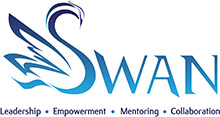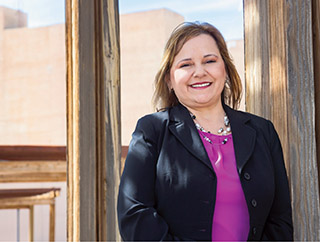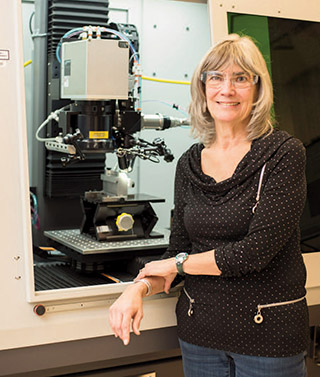Sandia marks Women’s History Month

March is Women’s History Month, and the 2016 theme, “Working to form a more perfect union,” celebrates women who have shaped America’s history and its future through their public service and government leadership.
It’s a fitting theme for the women of Sandia who embody the Laboratories’ core purpose: “To render exceptional service in the national interest.”
Sandia has a long history of promoting the success and contributions of women in the workplace, particularly in science, technology, engineering, and math (STEM) leadership. Notably, in 2015, Sandia President and Laboratories Director Jill Hruby became the first woman to lead a nuclear weapons laboratory.
Sandia’s outreach program, SWAN (Sandia Women’s Action Network), brings together women from all facets of the Laboratories and partners with the Sandia Women’s Committee at Sandia/California. SWAN exists to create and maintain a welcoming environment where women can advance their careers with ongoing networking and professional development opportunities.
The SWAN council, led by co-chairs Amy Tapia and Lori Parrott, is proud to recognize the courage and dedication of the outstanding women at Sandia.
Ann Campbell: The importance of contributing to something bigger
Ann Campbell grew up in Jamestown, a small city in western New York state. She comes from a long line of independent women.
Ann’s great grandmother, Matilda Lundburg, left Sweden in her teens by herself seeking a better life in America.

Ann’s grandmother, Isabel Campbell, was an amateur champion golfer at a time when there were few women in the sport. “She was comfortable in a man’s world,” Ann says, “I learned a lot from her as a role model.”
Ann’s mother, Helen Nelson Campbell, joined the Navy during World War II to serve in the WAVES (Women Accepted for Volunteer Emergency Service), the women’s branch of the US Naval Reserve.
“In her early 20s, my mother moved far away from home to work in the Supply Corps at the Charlestown Navy Yard, provisioning ships for the war effort. I have always found her example inspiring, because my mom says she was painfully shy as a young woman,” Ann says.
“What I got from my mom is the importance of service and contributing to something bigger.”
Fast forward to today, and Ann serves as director of Sandia’s Systems Assessment and Research Center. She leads a team of approximately 200 staff and managers who work on a range of national security issues related to nuclear weapons worldwide. Her program, she says, consists of a variety of activities including analysis, threat and vulnerability assessments, and research and technology development to support a broad range of US Government missions.
“Ann is amazing,” says Div. 5000 VP James Peery. “She is very humble, and likely won’t tell you about the activities she has led to strategically position the Labs. Perhaps the most significant example is cyber. Ann worked effectively to transform a small area into a synergistic mission area for the Labs. When we discuss future customer stewardship models, most of today’s examples have Ann’s fingerprints on them.”
Ann began her career at Sandia 30 years ago as a materials scientist. She earned her bachelor’s degree in materials engineering from Rensselaer Polytechnic Institute and her PhD in Applied Physics from Harvard University. At Harvard she was one of the first women in her program.
Ann says the key to her professional success has been a willingness to try new things.
“Sandia was the only national lab that I considered. The attraction for me was the breadth of the programs. I have learned so much from moving around and doing a lot of different things. I’ve had multiple careers under the same roof.”
Regarding the future of women in STEM careers, Ann says, “I’m very inspired by the women who I see come into the laboratory today. They are smart, creative, and they know what they want to do. My concern is that we don’t see enough young women going into STEM fields.”
What is the best advice she has ever received? “Be true to yourself,” she says. “I learned that from my mom.”
Outside of her busy work schedule, Ann enjoys being outdoors and spending time with her husband and their dog.
Miquelita Carrion: Inspiring at-risk youth in the community
Miquelita Carrion began her career at Sandia at age 16. She grew up in Albuquerque’s South Valley, where, she says, “I was taught family is first, and not your career.” A student at Rio Grande High School, she joined Business Professionals of America (BPA). Interested in the prospect of working in an office setting, she accepted an opportunity through BPA to work as a secretarial trainee with Sandia’s Yucca Mountain Project.

Miquelita Carrion
“I did not even know what Sandia Labs was,” she says. “In my community, I was never exposed. I had never met an engineer.”
Today, Miquelita serves as a project manager in the nuclear weapons stockpile program and a principal member of staff. Her manager, Valerie Mendoza says, “Miquelita has a passion to work on the hard problems, and she always finds a solution. We are very fortunate to have her on our team.”
First-generation college educated, Miquelita holds a bachelor’s degree in business management and a master’s degree in business administration. Her example has inspired hundreds of at-risk youth in the community.
Miquelita serves as the program coordinator for Manos, a Sandia-sponsored science and engineering outreach program for local, Hispanic middle school students. She has led Manos for more than 10 years and has volunteered since 1995. She gives hundreds of hours of community service because, she says, all young people, especially from economically challenged areas of the city, need to be introduced to STEM careers.
Manos reaches more than 150 students a year. This year, it has grown in collaboration with the National Hispanic Cultural Center and Albuquerque Public Schools.
“The Manos program is something much bigger than myself — it takes an entire village effort,” she says.
Manos is a partnership of Sandia’s HLOC (Hispanic Leadership Outreach Committee) and Community Involvement Dept. 3652. Community Involvement manager and SWAN co-chair Amy Tapia says, “Miquelita continuously strives to improve the Manos program and is willing to think outside the box to create more impact on students.”
Miquelita says Manos’ growth over the years is a testimony to how effective it is. “It started more than 25 years ago as a four-week program, and this year we have transitioned to year-round,” she says. “Now these students will have somewhere to go all year.”
Asked how she balances work and community with a blended family of five children and two granddaughters, Miquelita says, “It takes a lot of organization and a lot of juggling, just like my role as a project manager.”
Miquelita credits her success to the men and women mentors she has had at Sandia. “When I worked in human resources, I had a phenomenal manager named Linda Duffy. The moment I finished my bachelor’s degree, Linda told me I needed a master’s degree. She was always pushing me to further myself. I’m grateful she did and I really try to pay it forward with others.”
What is Miquelita’s advice for working mothers? “It’s about the quality of time you spend, not the quantity,” she says. “By supporting other women in the workplace with positive networks like SWAN (Sandia Women’s Action Network) and sharing our stories, we can have successful careers and happy families, too.”
Pierrette Gorman: Traded sewing for a shot at a science career
Pierrette Gorman built a successful career as a seamstress and tailor, working her way from bridal and clothing stores to owning a business in upstate New York. But something was wrong.
“I wanted to go to college. I wanted a college education,” Pierrette says. Even more daunting, she wanted to be an engineer.

Pierrette Gorman
“I knew my ability as a seamstress and differentiated myself from a home sewer,” she says. “I excelled in science and math, and there is a lot of engineering in tailoring. I especially enjoyed working with people who had disfigurements, and I could pad and fit their clothing so they looked complete.”
Pierrette started college in her 40s. She earned a degree in welding engineering, worked in industry, and found her way to Sandia Labs.
This month, Pierrette was named the winner of a 2016 STEP Ahead award by the Manufacturing Institute. The institute in 2012 launched the Science, Technology, Engineering and Production (STEP) Ahead initiative to honor and promote the role of women in the manufacturing industry through recognition, research, and leadership. The national honor identifies the best women in manufacturing and encourages them to mentor and support the next generation of women in manufacturing careers.
“It’s great to bring this award to Sandia,” says Pierrette, who will be honored at an April 21 gala in Washington, D.C. “Women who have received it in the past are from major companies like Toyota and 3M. I’m proud to add Sandia to that list.”
Welding was the best fit
Pierrette says she’s also proud to have started college later in life. She moved from New York to Utah in the early 1990s and left her business behind to enroll in a two-year pre-engineering program at Salt Lake City Community College, earning an associate’s degree. “That was where I first heard welding mentioned as a profession,” she says. “But I discounted it at the time.”
She moved to Ohio and was accepted into the Ohio State University College of Engineering, where she looked into various disciplines. Welding was the best fit. “They had 100 percent placement and they promised me I wouldn’t sit in an office all day long. I’d spend time in a lab, production floor, or field,” Pierrette says. “And welding engineers were one of the highest paid right out of college.”
While in school, Pierrette worked at the Edison Welding Institute in Columbus, Ohio, a 120-mile commute. “If you want something bad enough you do what you have to do to get it,” she says. “And I absolutely wanted it.”
She earned a bachelor’s degree in welding engineering and worked three years at Greatbatch Ltd. in Buffalo, New York, which makes implantable batteries for pacemakers, cochlear implants, and defibrillators.
In 1999, her husband’s work brought Pierrette to Albuquerque and a job at the laser deposition company Optimec. She joined Sandia in 2002 as a welding and soldering process engineer in neutron generators. She moved two and a half years ago to Metallurgy & Materials Joining, where she does research and development.
Pierrette is the single point of contact for welding requests to be processed in the Metallurgy & Materials Joining lab, conveying customer requirements to the welding technologists. She is also liaison between the design and the production agencies at the NNSA National Security Campus at Kansas City. “I team with both Sandia and Kansas City to write welding specifications, consult on weld joint design, and participate in the product development,” she says. “I also consult with contractors who build components for Sandia and for the National Security Campus.”
Women make great welders
Pierrette takes time to mentor young women interested in welding because that was missing in her life. “In high school girls were not allowed to take mechanical drawing,” she says. “There were absolutely no mentors. I didn’t know any women who were good in math and science.”
She speaks at high schools and community colleges, letting women know they can have careers in technical areas. And she’s on the board of directors of the American Welding Society with a vast district that stretches to Idaho and Montana, which gives her other opportunities to mentor women.
“Welding is thought of as a man’s field,” she says. “There is a huge need for all the different facets of welding careers, from engineers to solderers to inspectors. There are more jobs than people to fill them. The gap is huge and this is where we really need to get the word out to women that this is a good career. Women make great welders. It’s a precision skill.”
Pierrette says she often speaks to young women but would like to reach out as well to women in their 30s and 40s, perhaps displaced homemakers who didn’t go to college. “I want to show them they can do it, and how,” she says. “Sometimes I’ll speak at colleges and the guys will come up and say they are going to talk to their moms about it.”
Pierrette says that even though she started her welding career late there is plenty of time ahead. She says she feels lucky but that her husband says luck had nothing to do with it. “He says, no, you engineered your career,” she says. “I feel like I accomplished my number one goal of getting a college degree. Next I feel I’m still learning and excited. My career is still young.”